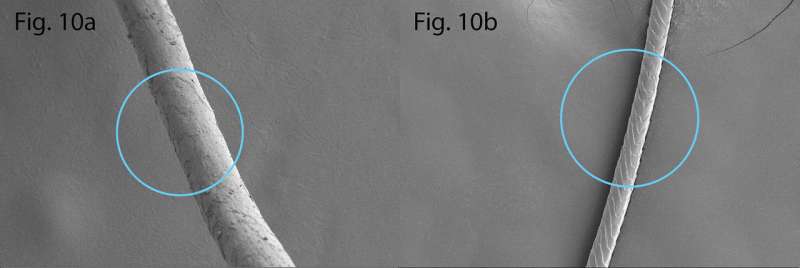Domestic goat dating back to the Neolithic Corded Ware period identified in Finland

Researchers report the first concrete evidence found in Finland of a goat dating back to the Neolithic Corded Ware period (in Finland ca. 2800-2300 BCE). The 4000-year-old animal was identified by its fossilised hair, which was found in an archaeological soil sample.
The research finding reveals evidence about the mortuary practices of the Corded Ware culture. The soil sample under investigation originated in a grave structure discovered in the 1930s in Kauhava, western Finland. The grave and its perimeter were encircled by a layer of dark soil resembling the dimensions of an animal skin. Since the hairs were found in the sample collected from this feature, the researchers believe that they are connected with a goat skin placed in the grave.
The identification is based on images taken with a scanning electron microscope. The fibres included in these images were identified on the basis of their structure, typical to goat hair. "Our study proves that completely new knowledge of our past can be gained by using microscopes to study organic material in advanced states of degradation. Now that we know to look for them, hairs have been found in other soil samples as well," says Tuija Kirkinen.
In the light of these new findings, it is reasonable to assume that domestic animals and a herder identity constituted a significant part of the belief system of the Corded Ware culture. This interpretation is also supported by objects made of domestic animal bones and pottery that might have been used for storing and drinking milk found in Corded Ware graves.
"Even though Corded Ware graves found elsewhere in Europe are generally better preserved, no equivalent evidence of skins placed in the grave have been found. As our findings show, the placement of the skin of an important domestic animal in the grave produces entirely new notions on the burial rituals and belief system of the Corded Ware culture," says Marja Ahola.
Oldest animal hair found in Finland
From the perspective of Finnish prehistory, the finding supports the evidence of animal husbandry practised during the Corded Ware period. In the field of Finnish archaeology, it has long been assumed that people also kept domestic animals during the Corded Ware period. This conclusion is based on the fact that during the period, people often lived in meadow environments suited to animal husbandry. Milk residues have also been found in Corded Ware pottery. It has been difficult to prove the practice of animal husbandry, since in the acidic Finnish soil, unburnt bone is preserved only for about 1000 years. Therefore, Finland has little osseous material preserved from the Stone Age. The oldest domestic animal bones known here, for example, date back only to the later part of Stone Age in ca. 2200-1950 BCE.
"The hairs found in the Corded Ware grave in Kauhava are the oldest animal hairs found in Finland and the first evidence of goats. Our finding does indeed prove that goats were known already at that early period as far up north as Finland," says Krista Vajanto.
More information: Ahola, M., Kirkinen, T., Vajanto, K. & Ruokolainen, J. 2017. On the scent of an animal skin: new evidence on Corded Ware mortuary practices in Northern Europe. Antiquity Vol 92, Issue 361, 118-131.
Journal information: Antiquity
Provided by University of Helsinki




















